Largest Ichthyosaurus Was Pregnant Mother: A ‘hidden’ Ichthyosaur Reveals Its Secrets
By Dean Lomax in Paleobiology |
Paleobiology | Ichthyosaurs were a highly successful group of marine reptiles that became extinct about 90 million years ago. The first ichthyosaur genus to be scientifically recognized was Ichthyosaurus, although other names had been in use. Thousands of Ichthyosaurus specimens are known, ranging from isolated bones to complete skeletons. The genus has been recorded from several locations across the UK, but some rare specimens have been reported from Europe and North America. The majority are from the coast around the Lyme Regis-Charmouth area, west Dorset, and from quarries in Street and surrounding areas in Somerset. Most of these were collected historically, during the early part of the 19th century. Ichthyosaurs were first brought to the attention of the scientific world by the Victorian fossil hunter and palaeontologist, Mary Anning.

With so many specimens known, it would be fair to assume that ‘everything has been studied and described’, but this could not be further from the truth. There are so many specimens that Ichthyosaurus is the most common Early Jurassic marine reptile in the UK. Through detailed examination of museum collections, we now have a much greater understanding of the genus and species therein. Presently, there are six valid species: Ichthyosaurus communis, I. breviceps, I. conybeari, I. anningae, I. larkini, and I. somersetensis. The species are distinguished from each other by major differences in the skull and humerus.
In 2003, as part of a major review of ichthyosaurs, a maximum length of 2.5 m was given for Ichthyosaurus. Recently, however, a very large, isolated forefin was described from the Early Jurassic of Yorkshire. This forefin was estimated to have belonged to an individual with a total length, from tip of the snout to end of the tail, of around 3 m. Due to the fragmentary remains, the specimen could not be assigned to a species. However, the largest species of the genus that could be identified was I. somersetensis, which was estimated to have been no longer than 3 m. That is, until the latest discovery.
In August 2016, whilst on a research trip to the Lower Saxony State Museum in Hannover, Germany, palaeontologist Sven Sachs saw a well-preserved, practically complete ichthyosaur skeleton on display in the museum. Sven sent some photographs to me, which I was very happy to receive! In early 2017, I joined up with Sven and visited the museum to study the specimen. I was quick to identify it as an example of Ichthyosaurus somersetensis, a new species that I had described previously.
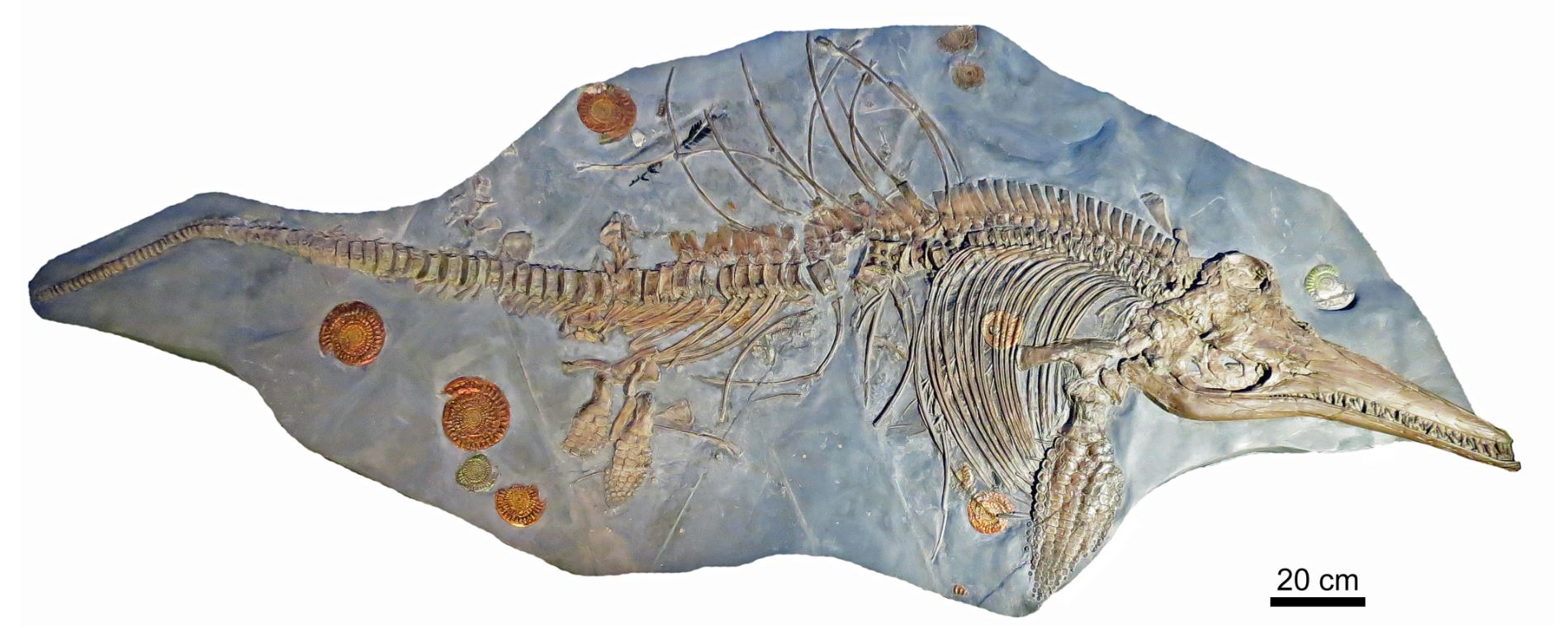
The museum records show that the new specimen was originally discovered on the Somerset coast, during the mid-1990s, and is from the Early Jurassic, roughly 200 million years old. The fossil had remained unstudied because it was held in a private collection prior to it being deposited into the museum in Hannover. Unlike the majority of historic specimens, the precise stratigraphic (age) and geographic details were recorded with this specimen, which is important. This may assist in uncovering such details in other examples where the information is unknown. Thus, increasing their scientific importance.
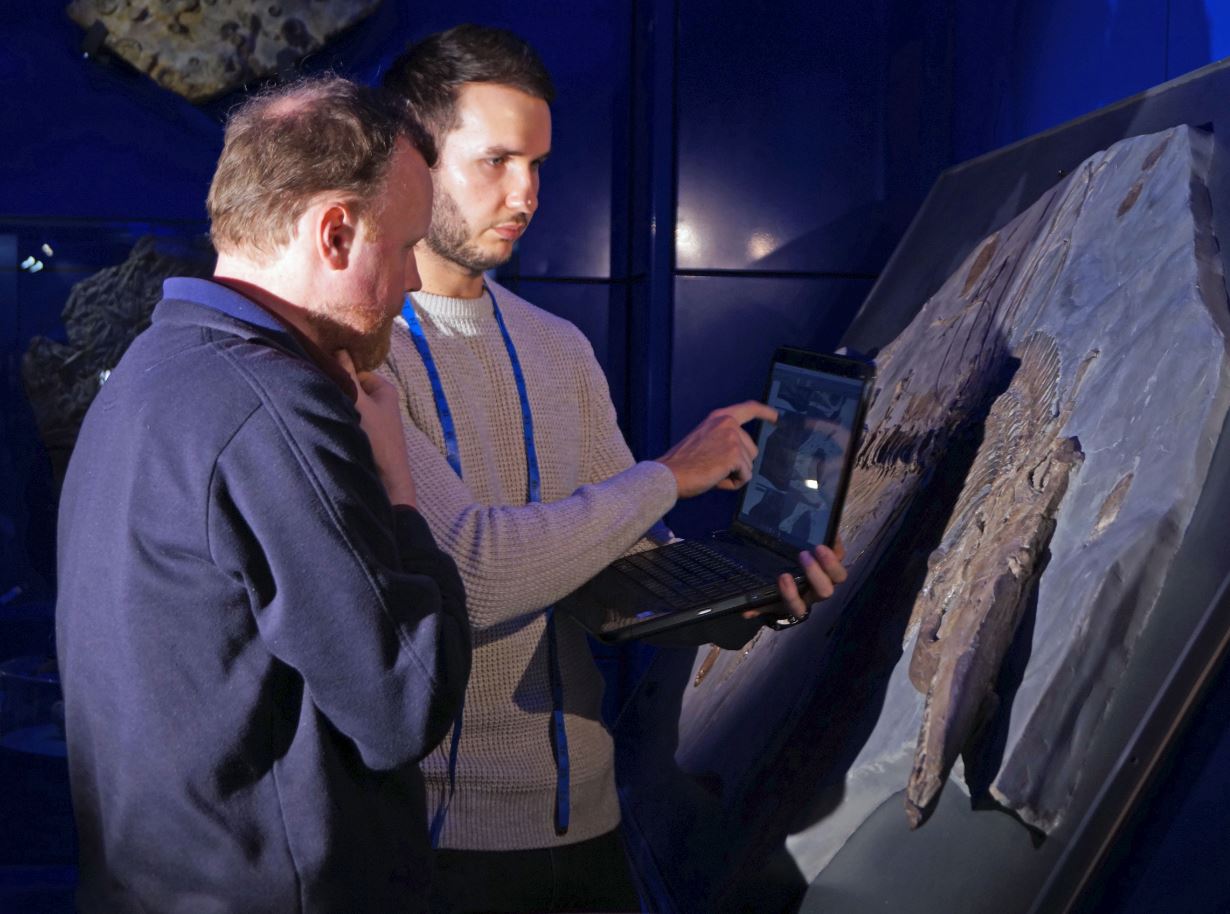
After careful examination, we found that something did not add up – the length. It appeared that the skull was too large for the body length. It turned out that almost the entire tail was added to the specimen, i.e. the tail composed of cast vertebrae and real vertebrae from another ichthyosaur, which made it appear more complete than what it really was. Such specimens are referred to as composites. Fortunately, the original collector details were recorded in the museum collections, so I decided to contact the collector to verify these findings. He was excited that this specimen was being studied and was happy to share information about the skeleton, which he had previously passed on. Based on the skull length, which is almost 60 cm [the largest skull length of any Ichthyosaurus on record], and the rest of the preserved skeleton, a total length, from tip of the snout to tip of the tail, was estimated between 3 and 3.5 m long. This is the largest unequivocal example of the genus known. An important addition to the scientific literature.
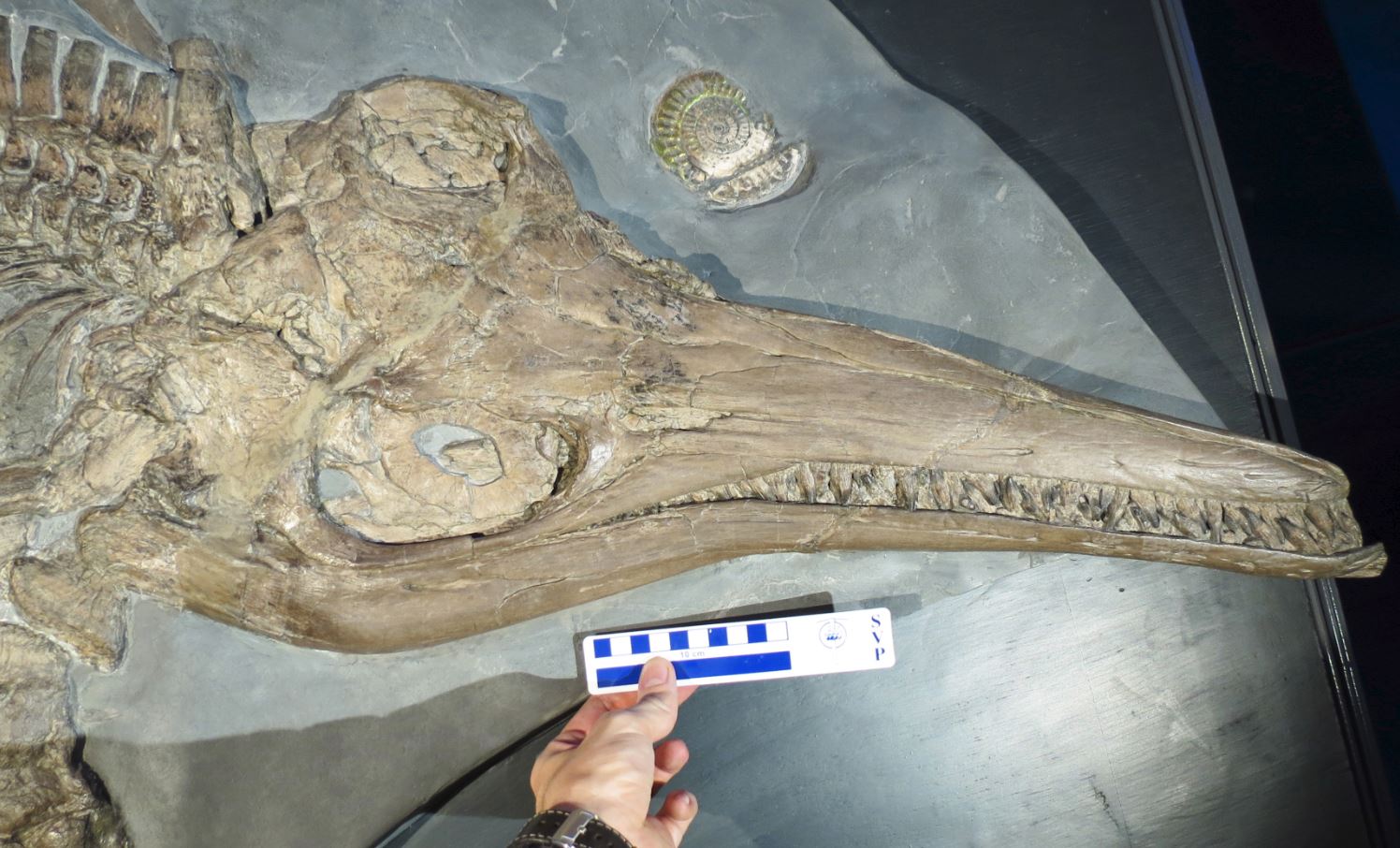
In fossils, it is super-difficult to work out the sex of the animal. At large, millions of years of fossilisation has not been kind to the soft parts! However, we were able to determine that this specimen was a female. We know this because there is an embryo preserved between the ribs. This is only the third Ichthyosaurus known with an embryo. The first was reported in 1846, and the second in 1993. Like this new specimen, both previous records are from Somerset. The embryo comprises a string of vertebrae, a partial forefin, ribs, and other bones. The preserved string of vertebrae is less than 7 cm long. The bones of the embryo are not fully ossified, meaning that the embryo was still developing at the time of death and thus the mother was not yet ready to give birth.
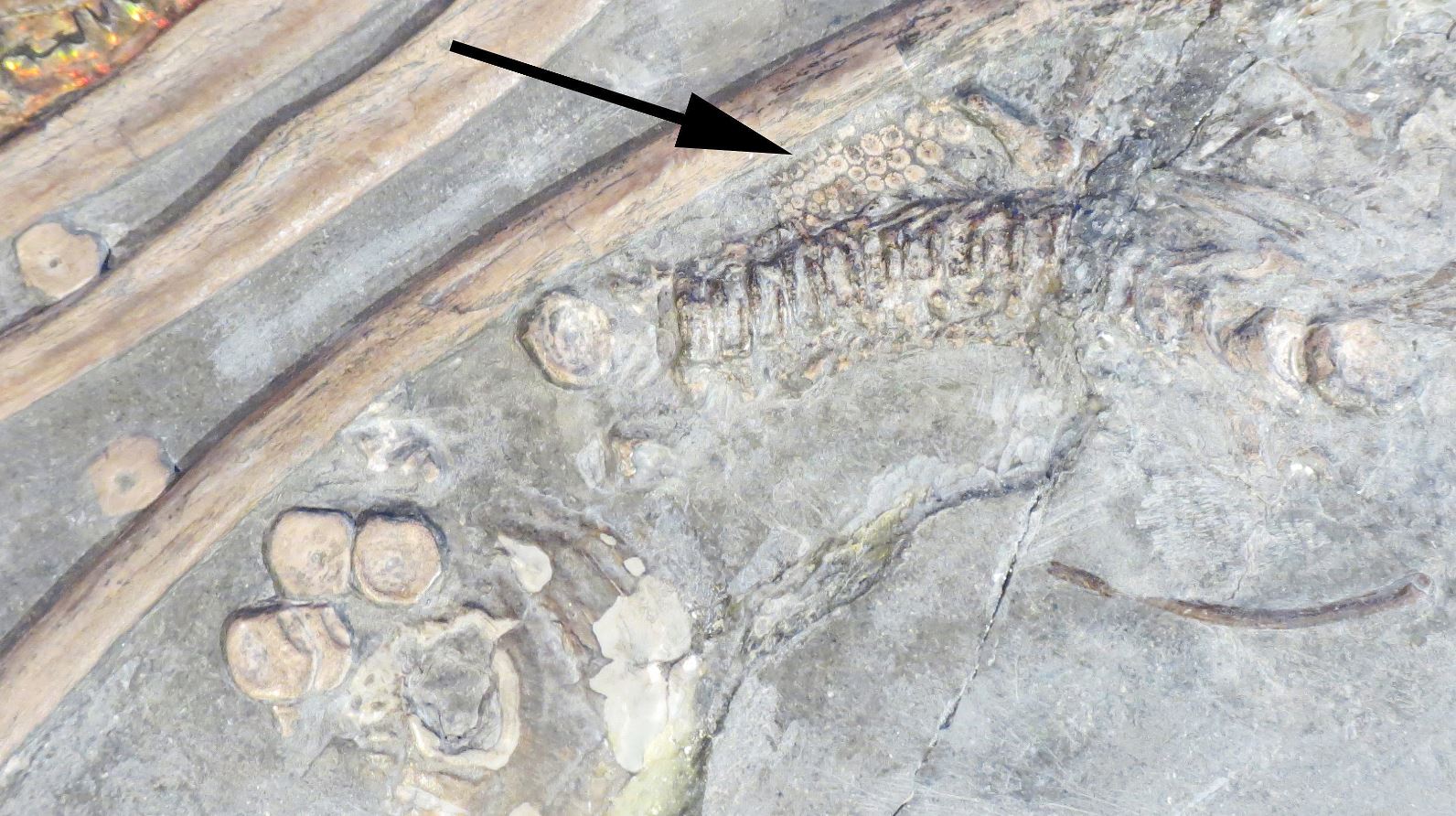
It is incredible that such specimens [the largest known example with an embryo] can still be found ‘hidden’ in collections. This specimen has provided new, valuable information on the genus and species, and will no doubt assist in future studies on Ichthyosaurus.
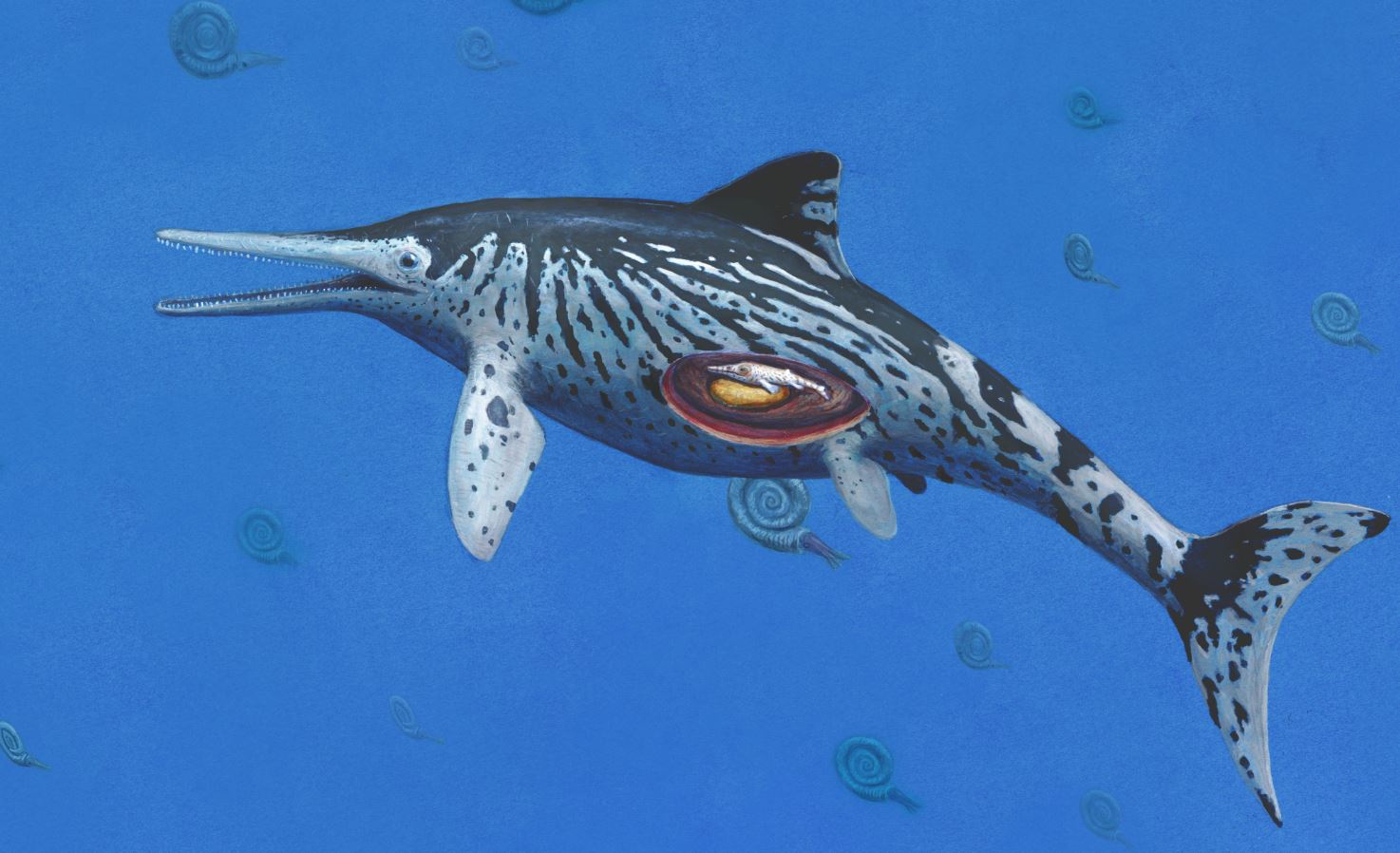
The new study was published in the scientific journal Acta Palaeontologica Polonica.
References & Further reading
De la Beche, H.T. and Conybeare, W.D. 1821. Notice of the discovery of a new fossil animal, forming a link between the Ichthyosaurus and crocodile, together with general remarks on the osteology of the Ichthyosaurus. Transactions of the Geological Society of London 5: 559–594.
Deeming, D.C., Halstead, L.B., Manabe, M., and Unwin, D. M. 1993. An ichthyosaur embryo from the Lower Lias (Jurassic: Hettangian) of Somerset, England, with comments on the reproductive biology of ichthyosaurs. Modern Geology 18: 423–442.
Lomax, D. R. and Massare, J. A. 2015. A new species of Ichthyosaurus from the Lower Jurassic of West Dorset, England. Journal of Vertebrate Paleontology 36: e1163264.
Lomax, D.R. and Massare, J.A. 2017. Two new species of Ichthyosaurus from the lowermost Jurassic (Hettangian) of Somerset, England. Papers in Palaeontology 3: 1–20.
Lomax, D. R. and Sachs, S. 2017. On the largest Ichthyosaurus: A new specimen of Ichthyosaurus somersetensis containing an embryo. Acta Palaeontologica Polonica 62: 575–584.
Lydekker, R. 1888. Note on the classification of the Ichthyopterygia (with a notice of two new species). Geological Magazine 5: 309–314.
McGowan, C. and Motani, R. 2003. Handbook of Paleoherpetology, Ichthyopterygia, Verlag Dr. Friedrich Pfeil, Munich.
Massare, J.A., Lomax, D.R., and Klein, A. 2015. A large forefin of Ichthyosaurus from the U.K., and estimates of the size range of the genus. Paludicola 10: 119–135.
Owen, R. 1881. Part 3. Ichthyopterygia. In A Monograph of the Fossil Reptilia of the Liassic Formations, pp. 83–134, Palaeontographical Society (Great Britain).
Pearce, J.C. 1846. Notice of what appears to be the embryo of an Ichthyosaurus in the pelvic cavity of Ichthyosaurus (communis?). Annals & Magazine of Natural History (First Series) 17: 44–46.
Torrens, H. S. 1995. Mary Anning (1799–1847) of Lyme; "the greatest fossilist the world ever knew". British Journal for the History of Science 28: 257–284.
Responses